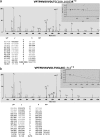In-depth analysis of tandem mass spectrometry data from disparate instrument types
- PMID: 18653769
- PMCID: PMC2596346
- DOI: 10.1074/mcp.M800021-MCP200
In-depth analysis of tandem mass spectrometry data from disparate instrument types
Abstract
Mass spectrometric analyses of protein digests produce large numbers of fragmentation spectra that are not identified by routine database searching strategies. Some of these spectra could be identified by development of improved search engines. However, many of these spectra represent fragmentation of peptide components bearing modifications that are not routinely considered in database searches. Here we present new software within Protein Prospector that allows comprehensive analysis of data sets by analyzing the data at increasing levels of depth. Analysis of published data sets is presented to illustrate that the software is not biased to any instrument types. The results show that these data sets contain many modified peptides. As well as searching for known modification types, Protein Prospector permits the detection and identification of unexpected or novel modifications by searching for any mass shift within a user-specified mass range to any chosen amino acid(s). Several modifications never previously reported in proteomics data were identified in these standard data sets using this mass modification searching approach.
Figures








References
-
- Deutsch, E. W., Lam, H., and Aebersold, R. ( 2008) Data analysis and bioinformatics tools for tandem mass spectrometry in proteomics. Physiol. Genomics 33, 18–25 - PubMed
-
- Perkins, D. N., Pappin, D. J., Creasy, D. M., and Cottrell, J. S. ( 1999) Probability-based protein identification by searching sequence databases using mass spectrometry data. Electrophoresis 20, 3551–3567 - PubMed
-
- Craig, R., and Beavis, R. C. ( 2004) TANDEM: matching proteins with tandem mass spectra. Bioinformatics 20, 1466–1467 - PubMed
-
- Klimek, J., Eddes, J. S., Hohmann, L., Jackson, J., Peterson, A., Letarte, S., Gafken, P. R., Katz, J. E., Mallick, P., Lee, H., Schmidt, A., Ossola, R., Eng, J. K., Aebersold, R., and Martin, D. B. ( 2008) The standard protein mix database: a diverse data set to assist in the production of improved peptide and protein identification software tools. J. Proteome Res. 7, 96–103 - PMC - PubMed
-
- Elias, J. E., and Gygi, S. P. ( 2007) Target-decoy search strategy for increased confidence in large-scale protein identifications by mass spectrometry. Nat. Methods 4, 207–214 - PubMed
Publication types
MeSH terms
Substances
Grants and funding
LinkOut - more resources
Full Text Sources
Other Literature Sources
Molecular Biology Databases
Research Materials

